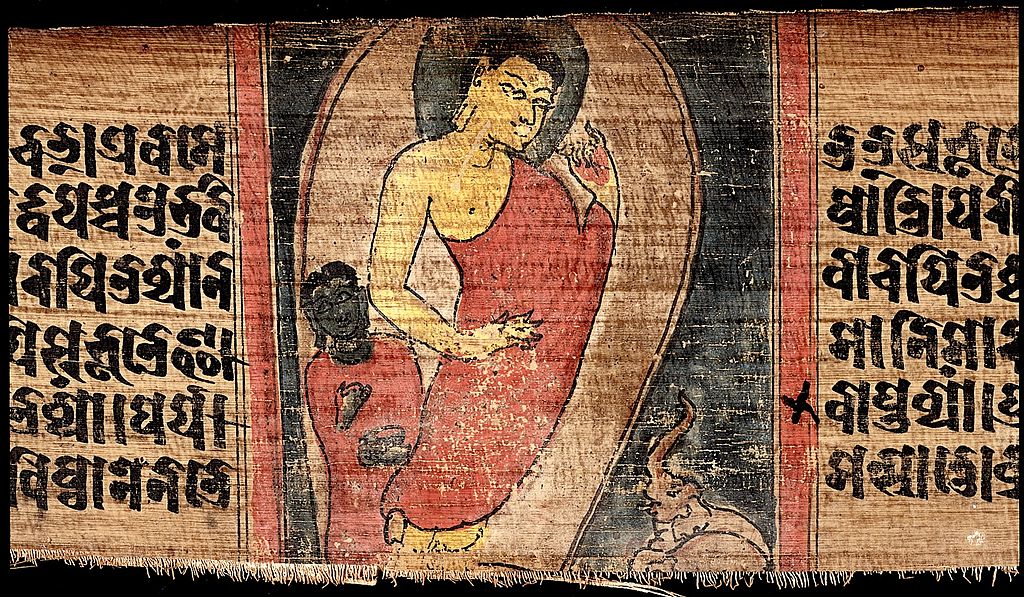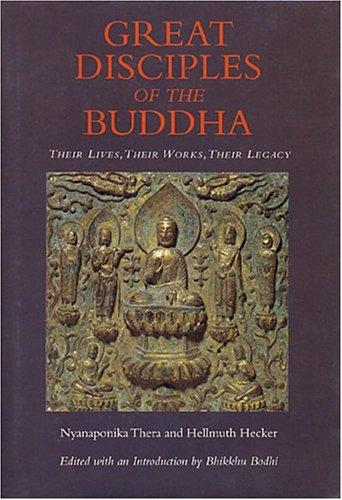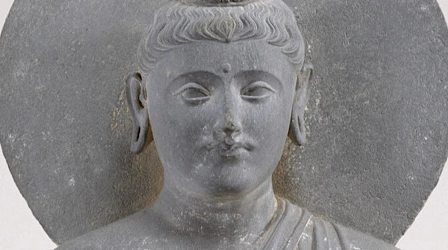Characters in the EBTs
Subscribe to this topic via: RSS
Even setting aside The Buddha himself, the Early Buddhist Texts are full of fascinating and compelling characters.

A closeup of a Sanskrit manuscript features a drawing of the Buddha with two characters: the joyful Ananda on the left and the elephant Nalagiri to the right. Stories of the early Saṅgha are found throughout Buddhist literature, from the Pāḷi Canon to northern texts such as this one in the Wellcome Collection.
Table of Contents
- Books (11)
- Canonical Works (77)
- Readings (30)
- Audio/Video (6)
- Reference Shelf (1)
- Related Topics (1)
Books (11)
Featured:
-
🥇 Best of
-
A collection of commentarial and canonical Pāli stories telling how the Buddha demonstrated his great compassion.
-
An anthology of stories about Buddhist women from the Pāli Canon.
See also:
Canonical Works (77)
Featured:
-
🥇 Best of
“It would not be appropriate for me to give the Buddha a powerful laxative.”
-
What kind of bhikkhu, friend Ānanda, could illuminate the Gosinga Sāla-tree Wood?
-
How is it possible that my husband detests me?
-
But because, Master Gotama, monks, nuns, celibate laymen, laymen enjoying sensual pleasures, celibate laywomen, and laywomen enjoying sensual pleasures have all succeeded in this teaching, this spiritual path is complete in that respect.
-
A collection of verses about, by, or associated with the Buddha’s foremost disciple in wisdom.
-
⭐ Recommended
Oh, what bliss! Oh, what bliss!
-
… sensual pleasures are time-consuming, full of suffering and despair, and the danger in them is greater still
-
‘Your outer robe of patches is soft, Kassapa.’–‘Venerable sir, let the Blessed One accept my outer robe of patches, out of compassion.’–‘Then will you wear my worn-out hempen rag-robes? ’–‘I will, venerable sir.’ Thus I offered the Blessed One my outer robe of patches and received from him his worn-out hempen rag-robes.
-
I had an only son called Nanda who I loved dearly. The rulers forcibly abducted him on some pretext and had him executed. But I can’t recall getting upset …
-
When Venerable Vakkali is ill, he asks the Buddha to visit him. The Buddha does so, but says there is no point in seeing his physical body, as one who sees the Dhamma sees him.
-
You’re right, brahmin, I don’t have
fourteen oxen
missing … -
A stuck-up brahmin listening to the Buddha is awestruck when the Buddha appears to read his mind.
-
Venerable Sāriputta and Venerable Mahāmoggallāna meditate together in peace not even a yakkha could disturb.
-
When Anāthapiṇḍika heard that a Buddha had arisen in the world, he rose first thing in the morning to go and visit him. But a mysterious darkness causes him to hesitate…
-
Mendicants, do you see Sāriputta walking together with several mendicants? … All of those mendicants have great wisdom.
-
This is indeed that Jeta’s Grove,
frequented by the Saṅgha of hermits… -
I cleared my divine eye and divine ear element to communicate with the Blessed One.
-
… right by my child’s half-eaten flesh.
-
Having these six qualities the householder Tapussa is certain
-
They’d look because of grasping, not by not grasping. In the same way, the notion “I am” occurs because of grasping form, feeling, perception, choices, and consciousness, not by not grasping.
-
Māra accuses the Buddha of having abandoned the path of true austerity.
-
A noble disciple who has these four things is a stream-enterer
1 page -
Venerable Vaṅgīsa thought, ‘This Venerable Sāriputta is educating the mendicants…’
-
I used to pay homage to constellations,
worshiping fire in the forest…
See also:
Readings (30)
Featured:
-
The narrative of Devadatta’s early monastic life should be understood as a literary device that shows him as fulfilling the prerequisites for being a schismatic.
-
A thorough, statistical survey of the Pāli suttas addressed to lay people, analyzing their breakdown by gender, caste, and attainment.
-
I have seen the Blessed One;
This is my last body,
And I will not go
From birth to birth again -
… in neither case do the terms function as indicators that the address or the detail of the teaching is solely for monks
-
A translation of the Tibetan parallel to MN 44, showcasing the Arahant Bhikkhunī Dhammadinnā’s profound explanations of the Dhamma.
-
Unlike others in the [Vessantara Jātaka], [Yasodharā] never breaks precepts, or puts her own wishes, however noble, before the needs and requirements that the beings in the immediate situation demand: she provides the true moral compass of the tale. […] Maddī, like Vessantara, has to give up everything, but, unlike him, she never lets go of her sense of interconnectedness with other beings: whether her husband, her family, her environment, or, perhaps, her vow
-
The Pali account of the physician Jīvaka illustrates a well-established āyurvedic medical tradition and preserves at least one practice not found in classical āyurveda.
-
… individual Brahmās (Sahāṃpati, Baka and an unnamed Brahmā) have different characters … lower than the Buddha and his great disciples[, their] individual names are a new design, not shared in the Vedic tradition of Brahmanism.
-
… one of the most outstanding testimonies to the Buddha’s capability as a teacher is the conversion of the killer Aṅgulimāla.
-
Reginald Ray has argued for a radical reassessment of Devadatta as a forest saint who was unfairly maligned in later monastic Buddhism. His work has been influential, but it relies on omissions and mistaken readings
-
… the queerness of the figure of Ānanda, whose name can be variously translated as “joy,” “bliss,” or “happiness,” fairly lept off the pages at me
10 pages -
As a result of his theft of soma, Vedic Namuci is said to be “wicked”…
2 pages
See also:
Audio/Video (6)
Featured:
See also:


